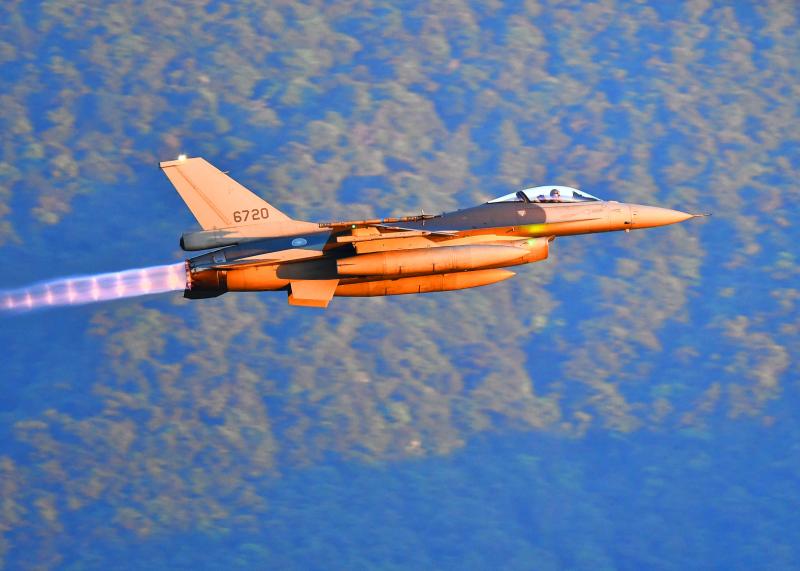The military yesterday simulated an invasion by the Chinese People’s Liberation Army (PLA) on the first day of the annual five-day live-fire phase of the Han Kuang military exercises.
The Ministry of National Defense’s Joint Operations Command Center, also known as the Hengshan Command Center, ordered F-16V jets from Hualien Air Force Base to conduct emergency takeoffs in batches from 5:30am yesterday to defend the airspace along the east coast.
Some fighter jets based in western Taiwan were dispatched to Hualien as part of a simulation in which most of the nation’s military bases in the west were “destroyed.”

Photo: Yu Tai-lang, Taipei Times
C-130 transport aircraft were used to take military personnel responsible for fighter jet maintenance, together with equipment and supplies, to designated locations in eastern Taiwan.
Naval vessels also set sail and troops practiced defense tactics as if they were being attacked by enemy planes or missiles.
The tabletop drills for the 38th edition of the Han Kuang exercises were carried out from May 16 to May 20, while the live-fire exercises are to conclude on Friday.
The live-fire exercises are divided into three parts — the military is to practice conserving its forces and air defense over the first two days, joint interception on the third day and joint territory defense on the last two days.
In related news, the Fisheries Agency posted a bulletin saying that the military and the Coast Guard Administration are to carry out a series of live-fire drills after the Han Kuang exercises are over.
Troops stationed in Penghu and Kinmen counties, and on Dongyin Island (東引) and the Pratas Islands (Dongsha Islands, 東沙群島) would conduct exercises next month and those stationed on Itu Aba Island (Taiping Island, 太平島) would do so in September, the bulletin said.
The Chungshan Institute of Science and Technology canceled artillery tests in Taiwan’s southeastern sea and airspace on Wednesday and Thursday, but the artillery drill on Wednesday and Thursday next week would be carried out, it said.
The Army Matsu Defense Command would conduct exercises at night on Friday and Saturday next week, the Army Kinmen Defense Command would choose 11 days to conduct artillery exercises from Thursday next week to Aug. 31 and the Army Penghu Defense Command would carry out exercises in the Wude (五德) region on Aug. 24 and Aug. 25, it said.
The coast guard would be in charge of the artillery exercises on the Dongsha Islands on Saturday next week and Aug. 13, followed by the exercises on Taiping Island on Sept. 20 and Sept. 21, it said.

The US government has signed defense cooperation agreements with Japan and the Philippines to boost the deterrence capabilities of countries in the first island chain, a report by the National Security Bureau (NSB) showed. The main countries on the first island chain include the two nations and Taiwan. The bureau is to present the report at a meeting of the legislature’s Foreign Affairs and National Defense Committee tomorrow. The US military has deployed Typhon missile systems to Japan’s Yamaguchi Prefecture and Zambales province in the Philippines during their joint military exercises. It has also installed NMESIS anti-ship systems in Japan’s Okinawa

‘WIN-WIN’: The Philippines, and central and eastern European countries are important potential drone cooperation partners, Minister of Foreign Affairs Lin Chia-lung said Minister of Foreign Affairs Lin Chia-lung (林佳龍) in an interview published yesterday confirmed that there are joint ventures between Taiwan and Poland in the drone industry. Lin made the remark in an exclusive interview with the Chinese-language Liberty Times (the Taipei Times’ sister paper). The government-backed Taiwan Excellence Drone International Business Opportunities Alliance and the Polish Chamber of Unmanned Systems on Wednesday last week signed a memorandum of understanding in Poland to develop a “non-China” supply chain for drones and work together on key technologies. Asked if Taiwan prioritized Poland among central and eastern European countries in drone collaboration, Lin

NO CONFIDENCE MOTION? The premier said that being toppled by the legislature for defending the Constitution would be a democratic badge of honor for him Premier Cho Jung-tai (卓榮泰) yesterday announced that the Cabinet would not countersign the amendments to the local revenue-sharing law passed by the Legislative Yuan last month. Cho said the decision not to countersign the amendments to the Act Governing the Allocation of Government Revenues and Expenditures (財政收支劃分法) was made in accordance with the Constitution. “The decision aims to safeguard our Constitution,” he said. The Constitution stipulates the president shall, in accordance with law, promulgate laws and issue mandates with the countersignature of the head of the Executive Yuan, or with the countersignatures of both the head of the Executive Yuan and ministers or

CABINET APPROVAL: People seeking assisted reproduction must be assessed to determine whether they would be adequate parents, the planned changes say Proposed amendments to the Assisted Reproduction Act (人工生殖法) advanced yesterday by the Executive Yuan would grant married lesbian couples and single women access to legal assisted reproductive services. The proposed revisions are “based on the fundamental principle of respecting women’s reproductive autonomy,” Cabinet spokesperson Michelle Lee (李慧芝) quoted Vice Premier Cheng Li-chiun (鄭麗君), who presided over a Cabinet meeting earlier yesterday, as saying at the briefing. The draft amendment would be submitted to the legislature for review. The Ministry of Health and Welfare, which proposed the amendments, said that experts on children’s rights, gender equality, law and medicine attended cross-disciplinary meetings, adding that